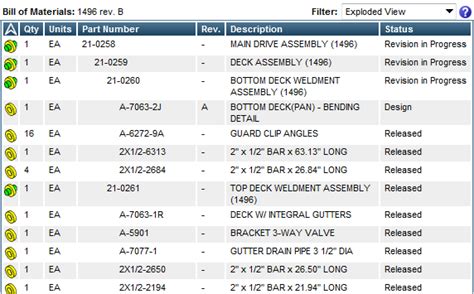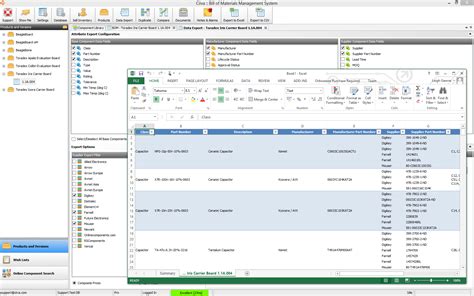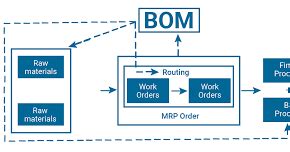The Challenges of Traditional BOM Management
Before diving into the benefits of a cloud-based BOM management solution, let’s first examine the challenges of traditional BOM management methods.
Manual Processes
Many companies still rely on manual processes for creating and managing BOMs, such as using spreadsheets or paper documents. These methods are prone to errors, version control issues, and data inconsistencies. As products become more complex and supply chains more global, manual BOM management becomes increasingly difficult to scale.
Lack of Collaboration
Traditional BOM management methods often lack real-time collaboration capabilities. This can lead to communication breakdowns between engineering, procurement, and manufacturing teams, resulting in delays and mistakes.
Limited Visibility
Without a centralized system, it can be challenging to gain visibility into the complete BOM structure, including subassemblies and lower-level components. This lack of transparency can make it difficult to identify potential issues or optimize designs for cost and performance.
Difficulty Managing Change
Product designs often evolve throughout the development process, requiring frequent updates to the BOM. With manual methods, managing these changes can be cumbersome and error-prone, leading to version control issues and potential production delays.
The Benefits of a Cloud-Based BOM Management Solution
A cloud-based BOM management solution can address many of the challenges associated with traditional methods, providing a more streamlined and efficient approach.
Centralized Data Management
With a cloud-based system, all BOM data is stored in a centralized location, accessible from anywhere with an internet connection. This eliminates the need for manual data entry and reduces the risk of errors and inconsistencies.
Real-Time Collaboration
Cloud-based BOM management solutions enable real-time collaboration between teams, regardless of location. Engineers, procurement specialists, and manufacturing personnel can all access and update BOM data simultaneously, improving communication and reducing the risk of mistakes.
Increased Visibility
A cloud-based system provides complete visibility into the BOM structure, including subassemblies and lower-level components. This transparency enables teams to identify potential issues early in the design process and make informed decisions about sourcing and production.
Automated Change Management
Cloud-based BOM management solutions often include automated change management capabilities, making it easier to track and implement design changes. This ensures that all teams are working with the most up-to-date version of the BOM, reducing the risk of production delays and quality issues.
Integration with Other Systems
Many cloud-based BOM management solutions can integrate with other enterprise systems, such as ERP, PLM, and CAD software. This enables seamless data exchange and eliminates the need for manual data entry, reducing the risk of errors and improving efficiency.

Key Features to Look for in a Cloud-Based BOM Management Solution
When choosing a cloud-based BOM management solution, there are several key features to consider:
Ease of Use
The system should be intuitive and user-friendly, with a minimal learning curve. Look for solutions with drag-and-drop functionality and customizable templates to streamline BOM creation.
Scalability
As your product portfolio grows, your BOM management solution should be able to scale with you. Look for a system that can handle large and complex BOMs, with the ability to manage multiple product lines and versions.
Security
With sensitive product data stored in the cloud, security is paramount. Look for a solution with robust access controls, encryption, and regular backups to ensure your data is protected.
Customization
Every company has unique BOM management needs. Look for a solution that can be customized to fit your specific workflows and requirements, with the ability to add custom fields and automate routine tasks.
Reporting and Analytics
A cloud-based BOM management solution should provide robust reporting and analytics capabilities, enabling you to gain insights into your product data and make informed decisions about sourcing, production, and inventory management.

BOM Management Solution Comparison
To help you choose the right cloud-based BOM management solution for your company, here’s a comparison of some of the top options on the market:
| Solution | Ease of Use | Scalability | Security | Customization | Reporting & Analytics |
|---|---|---|---|---|---|
| Arena BOM | High | High | High | Medium | High |
| OpenBOM | High | Medium | High | High | Medium |
| Upchain | Medium | High | High | Low | Medium |
| Aligni | High | Low | Medium | High | Low |
Note: Ratings are based on general industry reviews and may vary based on specific company needs and requirements.

Implementing a Cloud-Based BOM Management Solution
Once you’ve chosen a cloud-based BOM management solution, the next step is to implement it within your organization. Here are some best practices to ensure a smooth and successful implementation:
-
Define your goals and requirements: Clearly define your BOM management goals and requirements, and communicate them to all stakeholders involved in the implementation process.
-
Clean and organize your data: Before migrating your BOM data to the new system, take the time to clean and organize it, eliminating any duplicates or inconsistencies.
-
Train your team: Provide comprehensive training to all users of the new system, ensuring they understand how to create, manage, and update BOMs within the cloud-based solution.
-
Test and validate: Before going live with the new system, thoroughly test and validate it to ensure it meets your requirements and functions as expected.
-
Monitor and optimize: Once the system is up and running, continuously monitor its performance and gather feedback from users to identify areas for improvement and optimization.
Frequently Asked Questions (FAQ)
-
What is a bill of materials (BOM)?
A bill of materials (BOM) is a comprehensive list of all the components, parts, raw materials, and assemblies needed to create a product. -
Why is BOM management important?
Effective BOM management ensures that products are built correctly, on time, and within budget. It enables companies to streamline their manufacturing processes, reduce costs, and improve product quality. -
What are the benefits of a cloud-based BOM management solution?
A cloud-based BOM management solution offers several benefits, including centralized data management, real-time collaboration, increased visibility, automated change management, and integration with other enterprise systems. -
How do I choose the right cloud-based BOM management solution for my company?
When choosing a cloud-based BOM management solution, consider factors such as ease of use, scalability, security, customization, and reporting and analytics capabilities. Evaluate your company’s specific needs and requirements, and compare different solutions to find the best fit. -
What are some best practices for implementing a cloud-based BOM management solution?
Best practices for implementing a cloud-based BOM management solution include defining your goals and requirements, cleaning and organizing your data, training your team, testing and validating the system, and continuously monitoring and optimizing its performance.
Conclusion
In today’s fast-paced and competitive manufacturing landscape, effective BOM management is more critical than ever. By leveraging a cloud-based BOM management solution, companies can streamline their processes, improve collaboration, and gain greater visibility into their product data.
When choosing a cloud-based BOM management solution, it’s important to consider your company’s specific needs and requirements, and to evaluate different options based on factors such as ease of use, scalability, security, customization, and reporting and analytics capabilities.
By following best practices for implementation and continuously monitoring and optimizing the system, companies can realize the full benefits of a cloud-based BOM management solution, enabling them to build better products, faster and more efficiently than ever before.

Leave a Reply